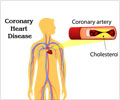There's new hope for potential heart attack victims. Researchers from Tel Aviv University have developed a new non-invasive technique that would help predict and treat attacks.
There's new hope for potential heart attack victims. Researchers from Tel Aviv University have developed a new non-invasive technique that would help predict and treat attacks.
The research team led by Dr. Sharon Zlochiver of the Department of Biomedical Engineering has shown that by looking at the electrical activity coupling two types of heart muscle cells one can identify an impending heart attack.The new technique can not only predict when a heart attack will occur, but it can also help doctors - and patients -buy time before a deadly attack takes place.
"Seventy percent of the heart is made up of myocytes, which are contractile muscle cells. The remaining 30 percent is mostly rigid structural cells called fibroblasts that work to hold the muscle in place," said Zlochiver.
"As the heart ages and contends with factors such as high blood pressure or genetic disease, this balance begins to change," he added.
Zlochiver developed a mathematical model that shows when the proportion of structural fibroblast cells are at dangerous levels, at approximately 70pct of the heart's volume, which is said to be the "tipping point" where a heart attack is imminent.
Studying the electric coupling - tiny electric signals - between myocytes and fibroblast cells, he was able to paint a more accurate picture of a heart's health than could be deduced from even an MRI or CT scan.
Advertisement
Indicating how the electrical impulses move in a healthy heart, in a synchronized ordered manner, he compares that to a diseased heart, where electric coupling is scattered and irregular and the impulses break into chaotic local "tornados."
Advertisement
Source-ANI
LIN















